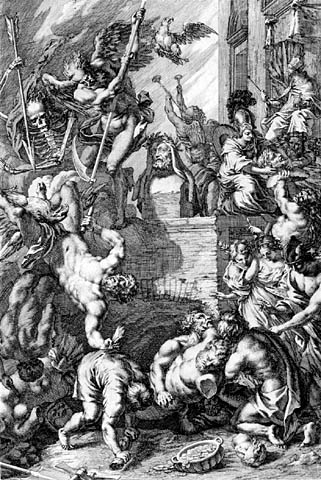February 23 - April 23, 2005
Past Presence: The Objects of Study at the Getty Research Institute
Curated by David Brafman

The new exhibition
Past Presence: Objects Of Study at the Getty Research Institute, on view from Feb. 23 - April 30, 2005 at the Grolier Club, explores how time -- past, present, and future -- is represented visually in objects that contribute to our knowledge about the history of art. The exhibition brings together highlights drawn from the special collections of the Research Library at the Getty Research Institute, one of the preeminent art libraries in the world.
Past Presence offers viewers an evocative exploration of time in rare books, photographs, sketches, architectural drawings, engravings, woodcuts and optical devices. The wide-ranging display looks at how artists, writers, and architects responded to notions of time and the urge to capture a moment, recreate the past, record the present, or imagine the future.
Past Presence is presented in association with the Getty Research Institute's 2004-05 research theme "Duration," which marks the 20th anniversary of its scholar program. Since 1985, the Getty has supported researchers working in residence at the Getty Center on projects related to the annual chosen theme. Twenty-nine scholars will be at the Getty conducting studies related to "Duration" this academic year. After the presentation at the Getty Center, the exhibition will travel to New York, where it will be on view from February 23-April 30, 2005 at the Grolier Club, the country's oldest and largest society for bibliophiles and enthusiasts of the graphic arts.
Past Presence is divided into four areas of exploration: Past, Presenting the Past, Present, and Future. The first section considers how art can portray the past as perfect or imperfect. Artists can return objects to an imagined state of former perfection, expressing a longing for an idealized past. In an 18th-century etching on view, Francesco Piranesi recreates a monument from the 1st-century B.C. In a similar way, an 1816 watercolor by English architect Joseph Michael Gandy romantically reconstructs the ancient city of Sparta. On the other hand, artistic depictions of the imperfect past record the damaging effects of time as in an engraving in an 18th-century catalogue for the British Museum showing an encrusted skull and corroded sword found in the Tiber River at Rome.
The show also examines how the past is preserved for the future by the present. The practice of collecting and displaying objects in a curiosity cabinet is an example of capturing and cataloguing the past. The exhibition features the earliest known copperplate engraving of a curiosity cabinet from 1622 as well as Marcel Duchamp's
Box, produced three centuries later in 1958. Duchamp arranged miniatures of his work in a boxed set, thus offering his career for sale as a commentary on collecting and curating. The ephemeral and eternal qualities of time emerge as artists try to capture a moment by drawing, painting, writing, printing, and taking photographs. A display of fireworks at Versailles in 1676 is preserved for memory by an engraving in a lavish fête-book published to commemorate a victory of Louis XIV. In a similar fashion, a photograph documents the Allan Kaprow performance "Durations" (1976), which marked the passing of time by the melting of ice blocks. Concluding the exhibition are artists' portrayals of the future, sometimes as a place of hope where visions will have been realized and goals achieved.
This desire to perfect the future can be seen in one of the earliest objects from the collections of the Getty Research Institute-the Renaissance designs for machines and devices drawn around 1475 by the Sienese architect Francesco di Giorgio Martini. Similar motifs are echoed in the 1933 Architectural Fantasies of Iakov Chernikhov, where powerful depictions of industrial might and design in Leningrad reflect optimism for the future of the Soviet state. But for every individual the future also holds the inevitable end. The exhibition includes
Art of Dying Well, a 1569 manual illustrated with woodcuts to instruct the good Christian in the decorum of final moments, and a 1982 triptych that playfully populates hell, purgatory, and paradise with stick figures of historical personalities and contemporary celebrities.
LOCATION AND TIMES: Past Presence: The Objects of Study at the Getty Research Institute will be on view at the Grolier Club from February 23 - April 30, 2005. Hours: Monday-Saturday 10 AM - 5 PM. Open to the public free of charge. Additional information is available on the
Getty website.